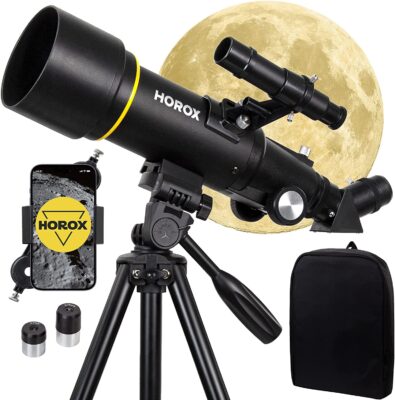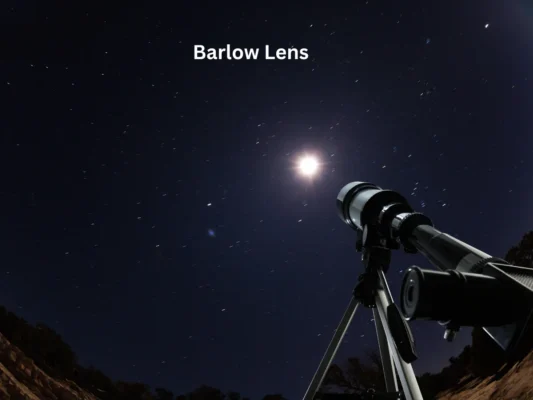If you have a child who loves gazing at stars and is looking for the best way to indulge their curiosity, then investing in a telescope may be just what they need. Telescopes are an exciting tool filled with possibilities that will help stimulate your child’s imagination and thirst for knowledge of space exploration.
Not only that, but it also teaches them the basic principles of physics like gravity and optics which can provide hours of fun learning experiences. In this blog post, we’ll look at some of the best telescopes for kids available to buy.
List of Top 7 Best Telescopes for Kids
Best telescopes for kids refer to a range of telescopes that are designed specifically for children to use for stargazing and exploring the night sky. These telescopes are typically lightweight, easy to use, and affordable, making them an ideal choice for parents who want to introduce their children to astronomy. Here is a list of some Best telescopes for kids.
[affiliatable id=’173139′]
Introducing the Bresser Junior Telescope 60/700 AZ Refractor Telescope. This telescope is ideal for exploring the night sky and discovering the secrets of the moon and planets like Saturn and Jupiter, as well as stunning star clusters like the Pleiades. With its 60/700 magnification, you’ll be able to investigate lunar craters in great detail.
The telescope is mounted with a 5×24 optical finder to make it easier to locate objects in the sky and comes with a 1.5x erecting lens to allow for even daytime exploration. To ensure comfortable viewing, a diagonal mirror has been included in the package. And thanks to its adjustable height tripod, users of all sizes can easily use this telescope.
All of this comes packaged together at 2kg complete weight. Included in your purchase is a telescope with a tripod, a 5×24 optical finder, 3 eyepieces (20mm, 12.5mm, 4mm), a 1.5x erecting lens, and manual everything you need for your night or day exploration of stars and planets alike.
Specifications
| Brand |
BRESSER |
| Optical Tube Length |
700 Millimeters |
| Eye Piece Lens |
Barlow |
| Objective Lens Diameter |
60 Millimeters |
| Telescope Mount |
Altazimuth Mount |
| Focus Type |
Manual Focus |
| Finderscope |
Reflex |
| Item Weight |
5000 Grams |
[joomdev-wpc-pros-cons disable_title=”yes” wpc_style=”wppc-view1″ title_tag=”H3″ title=”Title Here” pros_title=”Pros” cons_title=”Cons” button_text=”Get it now” disable_button=”yes” button_link=”” button_link_target=”_SELF” button_rel_attr=”dofollow” verdict_text=””][joomdev-wpc-pros]
- Easy to use for both amateur and experienced stargazers.
- Enjoy higher magnifications with the reverse lens.
[/joomdev-wpc-pros][joomdev-wpc-cons]
[/joomdev-wpc-cons][/joomdev-wpc-pros-cons]

The Telescope 114AZ Newtonian Reflector Telescope is the perfect tool for amateur astronomers looking to explore the mysteries of space. This telescope has a powerful 114mm Newtonian reflector and is specially designed for beginner astronomy enthusiasts.
With its high-quality optics, it offers up enhanced image brightness and clarity with fully coated primary mirrors. It also includes two special accessories an Adapter Star-Pointer red dot finderscope which helps you quickly point your scope at objects you want to observe, and a 1.25″ 13% Transmission Moon Filter to boost contrast and help you discern details on the moon.
Together with K10mm and K20mm eyepieces, this telescope offers low to high magnification so that you can get the most out of your viewing experience. Start learning more about space with Telescope 114AZ Newtonian Reflector Telescope today.
Specifications
| Brand |
SOLOMARK |
| Eye Piece Lens |
Barlow |
| Objective Lens Diameter |
114 Millimeters |
| Telescope Mount |
Altazimuth Mount |
| Focus Type |
Manual Focus |
| Power Source |
Adapter |
| Finderscope |
Reflex |
| Item Weight |
11.9 Pounds |
[joomdev-wpc-pros-cons disable_title=”yes” wpc_style=”wppc-view1″ title_tag=”H3″ title=”Title Here” pros_title=”Pros” cons_title=”Cons” button_text=”Get it now” disable_button=”yes” button_link=”” button_link_target=”_SELF” button_rel_attr=”dofollow” verdict_text=””][joomdev-wpc-pros]
- High-quality optics.
- Includes special accessories to help you find objects quickly.
- Inspire your creativity through starry night skies.
[/joomdev-wpc-pros][joomdev-wpc-cons]
- Bulky and difficult to move.
[/joomdev-wpc-cons][/joomdev-wpc-pros-cons]

Introducing the HOROX 70mm Aperture 400mm Refractor Telescope, the coolest moon watching gear around! This telescope is an absolute must-have for space enthusiasts of all ages, boasting a high-quality large 70mm diameter glass objective lens and 400mm focal length, which works together to create stunning images of the moon. Installation is incredibly easy with its professional grade aluminum tripod, offering adjustable heights for both adults and kids.
Plus, it comes fully loaded with two replaceable Kenller eyepieces (K20mm and K9mm), offering 20x-44x magnifications, as well as a 5×24 finder scope with a crosshair to make locating objects quick and easy. With everything you need included in this package, you’ll be ready to explore the wonders of the night sky in no time at all. Get your HOROX 70mm Aperture 400mm Refractor Telescope today and experience the full power of outer space like never before.
Specifications
| Brand |
HOROX |
| Model Name |
HX70x400 |
| Optical Tube Length |
400 Millimeters |
| Eye Piece Lens |
Kellner |
| Objective Lens Diameter |
70 Millimeters |
| Telescope Mount |
Altazimuth Mount |
| Product Dimensions |
17.32″D x 11.41″W x 5.72″H |
[joomdev-wpc-pros-cons disable_title=”yes” wpc_style=”wppc-view1″ title_tag=”H3″ title=”Title Here” pros_title=”Pros” cons_title=”Cons” button_text=”Get it now” disable_button=”yes” button_link=”” button_link_target=”_SELF” button_rel_attr=”dofollow” verdict_text=””][joomdev-wpc-pros]
- Enjoy a magical, up-close view of the stars and moon.
- Inspire your creativity through starry night skies.
- 70mm large diameter glass objective lens.
[/joomdev-wpc-pros][joomdev-wpc-cons]
- Not be powerful enough for some users who want to see more detail.
[/joomdev-wpc-cons][/joomdev-wpc-pros-cons]

The KIOSESI Telescope is perfect for exploring the mysteries of nature. With its powerful magnification capabilities, it can magnify up to 200x using its 3x Barlow lens and two eyepieces (H20mm and H6mm), allowing for detailed viewing of animals during the day or planetary viewing with a moon filter at night.
This refractor telescope has a long focal length of 400mm, a 70mm aperture, and a high-quality optical lens that allow you to observe farther distances while keeping clarity in your images. It is a great choice for adults, kids, and even astronomy beginners who want to get a better look at the wonders of nature.
With its advanced features and optimal performance, this telescope makes an ideal gift for those interested in astronomy or just starting out.
Specifications
| Brand |
KIOSESI |
| Eye Piece Lens |
Barlow |
| Objective Lens Diameter |
70 Millimeters |
| Focus Type |
Manual Focus |
| Power Source |
Adapter |
| Finderscope |
Reflex |
| Lens Coating |
Fully Coated |
[joomdev-wpc-pros-cons disable_title=”yes” wpc_style=”wppc-view1″ title_tag=”H3″ title=”Title Here” pros_title=”Pros” cons_title=”Cons” button_text=”Get it now” disable_button=”yes” button_link=”” button_link_target=”_SELF” button_rel_attr=”dofollow” verdict_text=””][joomdev-wpc-pros]
- Magnify up to 200X.
- Ability to observe distant objects.
- High-magnification telescopes.
[/joomdev-wpc-pros][joomdev-wpc-cons]
- Difficult to use for beginners.
[/joomdev-wpc-cons][/joomdev-wpc-pros-cons]

The ESSLNB Telescope is an excellent telescope for children, adults, and astronomy novices. It has a 400mm focal length and a big 80mm objective lens, along with a multi-fully high transmission coated all-optical lens to ensure enhanced image brightness and clarity. It also comes with 1.25″ high power interchangeable eyepieces (K9mm, K25mm) as well as a 3X Barlow lens which provides up to three times magnification power.
The package also includes a protective cover, adjustable tripod (with tray included), finder scope, and phone adapter with 10X eyepiece. Made with the highest quality materials, this telescope is designed to make your stargazing experience enjoyable and easy so you can explore the night sky like never before.
Specifications
| Brand |
ESSLNB |
| Eye Piece Lens |
Kellner |
| Objective Lens Diameter |
80 Millimeters |
| Product Dimensions |
25″D x 25″W x 51.6″H |
| Focus Type |
Manual Focus |
| Finderscope |
Reflex |
| Item Weight |
8.23 Pounds |
[joomdev-wpc-pros-cons disable_title=”yes” wpc_style=”wppc-view1″ title_tag=”H3″ title=”Title Here” pros_title=”Pros” cons_title=”Cons” button_text=”Get it now” disable_button=”yes” button_link=”” button_link_target=”_SELF” button_rel_attr=”dofollow” verdict_text=””][joomdev-wpc-pros]
- 400mm focal length.
- 80mm objective diameter for improved image brightness.
- 1.25″ high power interchangeable eyepieces.
- 3X Barlow lens to improve magnification.
[/joomdev-wpc-pros][joomdev-wpc-cons]
- Assembly and use can be complicated.
[/joomdev-wpc-cons][/joomdev-wpc-pros-cons]

The BOBLOV Astronomical Telescope is the perfect device for aspiring astronomer. It comes with a wonderful 700MM focal length refractor telescope, with a 70MM large aperture objective lens that is ideal for exploring outer space and objects such as the moon and planets. The telescope includes professional optical accessories like fully coated lenses and 45° zenith mirrors, which provide high transmission so you can enjoy wide viewing fields with clarity.
Also included are two replaceable eyepieces (25MM and 10MM) plus a 3x Barlow lens that increases magnification power three-fold, allowing stunningly bright and clear images to be seen. To top it all off, the BOBLOV Astronomical Telescope has an adjustable tripod for stability and convenience during use. Invest in this device today and be ready to explore the stars.
Specifications
| Brand |
BOBLOV |
| Optical Tube Length |
700 Millimeters |
| Eye Piece Lens |
Barlow |
| Objective Lens Diameter |
70 Millimeters |
| Product Dimensions |
23.23″D x 5.12″W x 8.27″H |
[joomdev-wpc-pros-cons disable_title=”yes” wpc_style=”wppc-view1″ title_tag=”H3″ title=”Title Here” pros_title=”Pros” cons_title=”Cons” button_text=”Get it now” disable_button=”yes” button_link=”” button_link_target=”_SELF” button_rel_attr=”dofollow” verdict_text=””][joomdev-wpc-pros]
- agnify the stars and outer space up to 21 times with this telescope.
- 70MM large aperture of the objective lens.
- Create magical memories of star gazing with friends and family.
[/joomdev-wpc-pros][joomdev-wpc-cons]
[/joomdev-wpc-cons][/joomdev-wpc-pros-cons]

The ABOTEC 80mm Telescope is an ideal telescope for adults and kids alike. With an 80mm aperture and a fully coated optics glass lens, this telescope captures more light for brighter and clearer images. It comes with three eyepieces (K6mm, K10mm, K25mm) and a 3X Barlow lens to provide 25x-250x high magnification with a 500mm focal length. Whether you’re observing the moon or viewing planets, this telescope can meet your needs.
Plus, it is lightweight and portable so you can take it anywhere, yet sturdy enough to stay stable during observation. No matter if you’re an astronomy beginner or a hobbyist, the ABOTEC 80mm Telescope will bring you closer to the stars.
Specifications
| Brand |
ABOTEC |
| Eye Piece Lens |
Barlow |
| Objective Lens Diameter |
80 Millimeters |
| Focus Type |
Manual Focus |
| Power Source |
Adapter |
| Finderscope |
Reflex |
| Number of Batteries |
1 CR2032 batteries required. (included) |
| Lens Coating |
Fully Coated |
| Focal Length |
500 millimeters |
[joomdev-wpc-pros-cons disable_title=”yes” wpc_style=”wppc-view1″ title_tag=”H3″ title=”Title Here” pros_title=”Pros” cons_title=”Cons” button_text=”Get it now” disable_button=”yes” button_link=”” button_link_target=”_SELF” button_rel_attr=”dofollow” verdict_text=””][joomdev-wpc-pros]
- Lightweight.
- Portable.
- 3 eyepieces and Barlow lens.
[/joomdev-wpc-pros][joomdev-wpc-cons]
- Requires manual adjustments.
[/joomdev-wpc-cons][/joomdev-wpc-pros-cons]

Buying Guide
Buying the best telescopes for kids can be a daunting task for parents who are not astronomy enthusiasts themselves. However, choosing the right telescope is crucial if you want your child to be able to enjoy the wonders of the night sky. Telescopes can help spark a lifelong love for science and astronomy, and it’s essential to pick one that is suitable for your child’s age, experience level, and interests. Here are some tips to help you choose the best telescope for your kid.
Choose a telescope that is easy to use:
It’s essential to choose a telescope that your child can easily operate. A telescope that is too complicated or difficult to use may frustrate your child and dampen their enthusiasm for astronomy. Look for models that have simple and intuitive controls, with clear instructions and a manual that is easy to follow.
Consider the size and weight:
Telescopes come in different sizes and weights, and you need to choose one that is suitable for your child’s age and physique. A large and heavy telescope may be difficult for your child to move around and set up, which can be frustrating. On the other hand, a small and lightweight telescope may be too simple and limit your child’s ability to explore the night sky fully.
Opt for good optics:
The quality of the optics is a crucial factor in the performance of a telescope. A good-quality telescope will have clear and sharp images, while a subpar one will produce blurry and distorted images. Look for models that have high-quality lenses or mirrors, and that offer good magnification and a wide field of view.
Look for additional features:
Some telescopes come with additional features that can make stargazing more fun and exciting. For example, some models come with built-in computerized systems that can help your child locate and track celestial objects automatically. Other telescopes may have filters that enhance the visibility of planets, or eyepieces that improve the quality of the image.
Avoid toy telescopes:
Although toy telescopes may seem like a good idea for younger children, they offer poor optics and limited viewing capabilities. They may also be frustrating to use, which can discourage your child from pursuing their interest in astronomy. Invest in a good-quality telescope that your child can grow with and continue to use as they advance in their skills and knowledge.
You can check reviews of telescopes here
Conclusion:
Choosing the best telescope for your child will depend on several factors, including their age, experience level, and interests. Consider the size, weight, and quality of the optics, as well as any additional features that may enhance your child’s stargazing experience. Avoid toy telescopes and invest in a good-quality model that your child can grow with and enjoy for years to come. With the right telescope, your child can explore the wonders of the night sky and develop a lifelong love for astronomy.
FAQs for Best Telescopes for Kids
What features should I look for in a telescope for my child?
When choosing a telescope for kids, it is important to consider the size and weight of the device, as well as the type of mount and the quality of the optics. Look for a telescope with a durable, stable tripod and a small aperture, as these will be easier for kids to handle and use effectively.
Which type of telescope is best for kids?
For children, a refracting telescope is often the easiest to use, as it requires less maintenance and is less prone to misalignment than a reflecting telescope. Refractor telescopes also generally have a wider field of view, which can make it easier for kids to locate and focus on objects in the sky.
How much should I spend on a telescope for my child?
The price of a telescope can vary widely depending on the quality and complexity of the device. In general, a basic telescope suitable for kids can be found for around $100 to $200. While it may be tempting to go for a cheaper model, be aware that a low-quality telescope can be frustrating to use and may not provide clear images.
What can my child see with a telescope?
With a good telescope, kids can spot a range of celestial objects, from the moon and stars to distant planets and galaxies. Depending on the time of year and local conditions, they may be able to see constellations, nebulae, and even comet tails.
How can I help my child get the most out of their telescope?
To ensure your child gets the most out of their telescope, it’s important to provide guidance and support. Explain how the device works and how to focus it properly. Encourage them to take notes on their observations and explore different settings and configurations. And most importantly, share in their enthusiasm and celebrate their discoveries.




















